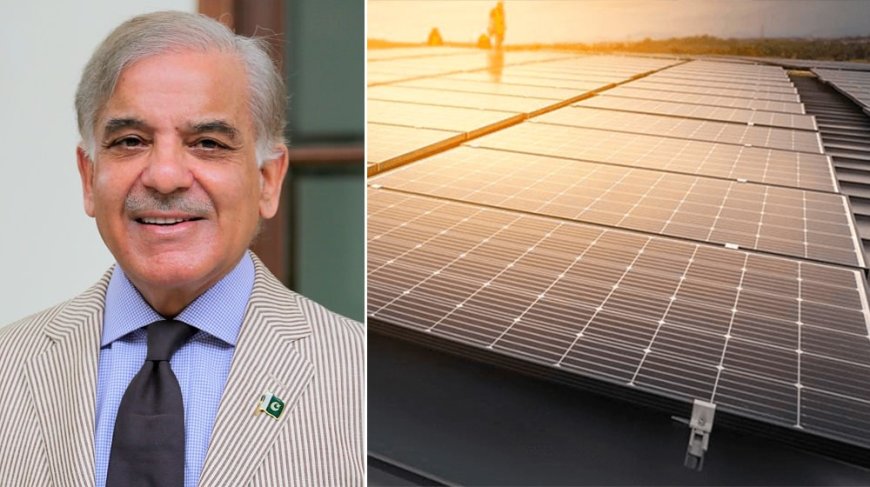PM Shehbaz Orders Review of Solar Net Metering Rate Cut
PM Shehbaz orders urgent review of proposal to halve solar net metering rate amid financial, legal, and grid concerns.

Prime Minister Shehbaz Sharif has directed an immediate reassessment of the proposed solar net metering rate reduction, instructing the Power Division and the National Electric Power Regulatory Authority (NEPRA) to thoroughly examine the potential impact of the new pricing model before any decision is made.
The directive came during a high-level meeting on October 22, where officials from the Power Division presented a proposal to halve the buyback rate the price paid to households and businesses selling surplus solar electricity to the grid from around Rs. 22 per unit to Rs. 11.30 per unit.
Financial Strain Behind the Proposal
According to officials, the rate cut was suggested to offset the financial burden created by the rapid expansion of rooftop solar systems. Over the past few years, thousands of households have installed small-scale solar panels under the national net metering framework, allowing them to export excess power to the grid.
Government data shows that this trend has reduced grid electricity sales by roughly 3.2 billion kilowatt-hours (kWh) in FY2024, translating into an additional Rs. 101 billion in costs shared among other consumers. Power planners warn that, if unchecked, the effect could grow substantially grid sales could fall by 18.8 billion kWh by FY2034, adding nearly Rs. 545 billion in extra costs and pushing tariffs higher for non-solar users.
Officials argue that such imbalances make it difficult to maintain fair electricity pricing for the wider population, especially when the number of solar consumers is projected to keep rising.
Prime Minister’s Directive for a Balanced Policy
While acknowledging the financial pressures, Prime Minister Shehbaz urged the authorities to take a balanced approach that does not discourage renewable energy adoption.
“Solar power has empowered thousands of families to reduce their electricity bills and support the national grid,” the Prime Minister reportedly said. “We must ensure that policy reforms protect the broader economy without undermining Pakistan’s renewable energy transition.”
He instructed the Power Division and NEPRA to conduct a detailed technical review, consult with industry experts, consumer groups, and legal advisors, and submit a comprehensive report outlining the economic and environmental implications of any rate adjustment.
Legal Review and Contractual Commitments
A major concern for the government is whether existing net metering contracts which guarantee specific buyback rates for several years can be revised without violating legal terms.
The Power Division has been tasked with examining contract clauses to determine if changes can be implemented lawfully. Simultaneously, officials are drafting new standardized agreements for upcoming solar customers under a proposed Net Billing framework, which would credit only the difference between electricity produced and consumed, rather than paying a fixed rate for all exported units.
Legal experts caution that any retroactive rate revision could lead to disputes and damage investor confidence in Pakistan’s renewable sector, particularly among small businesses that invested in solar systems based on stable return forecasts.
Operational Challenges for Grid Stability
Beyond fiscal issues, the national grid is facing technical stress due to high daytime solar generation. During peak sunlight hours, electricity supply from rooftop systems often exceeds demand in some regions, forcing operators to temporarily restore high-loss feeders or reduce conventional generation to stabilize the system.
Energy planners warn that unregulated growth could lead to more than 8,000 megawatts (MW) of solar capacity connected through net metering by FY2034—a “forced addition” that could disrupt long-term least-cost generation planning.
Expert Opinions on the Way Forward
Energy experts say the review ordered by the Prime Minister is an opportunity to restructure the policy with transparency and data-driven decision-making.
“The solution is not to punish solar users but to update the pricing model so it reflects real-time grid costs,” said Dr. Nida Aslam, an independent energy economist. “Pakistan can sustain solar growth if pricing, contracts, and grid investments evolve together.”
She added that a gradual transition toward net billing, combined with time-of-use tariffs and localized storage solutions, could help balance solar incentives with grid reliability.
Next Steps
The Power Division and NEPRA are now expected to finalize their joint assessment in the coming weeks. The report will outline the economic impact, legal feasibility, and operational implications of adjusting the solar buyback rate.
For now, the government maintains that no final decision has been made. Officials insist that any reform will be guided by public interest, energy equity, and Pakistan’s long-term renewable strategy.
As the country works to stabilize its power sector and expand clean energy, the outcome of this review will determine how Pakistan balances sustainability with financial prudence a defining test for the nation’s evolving energy policy.
For more upadtes, Visit Nation bytes

 Israr Ahmed
Israr Ahmed